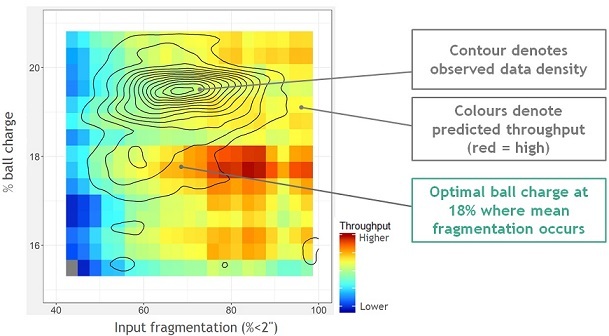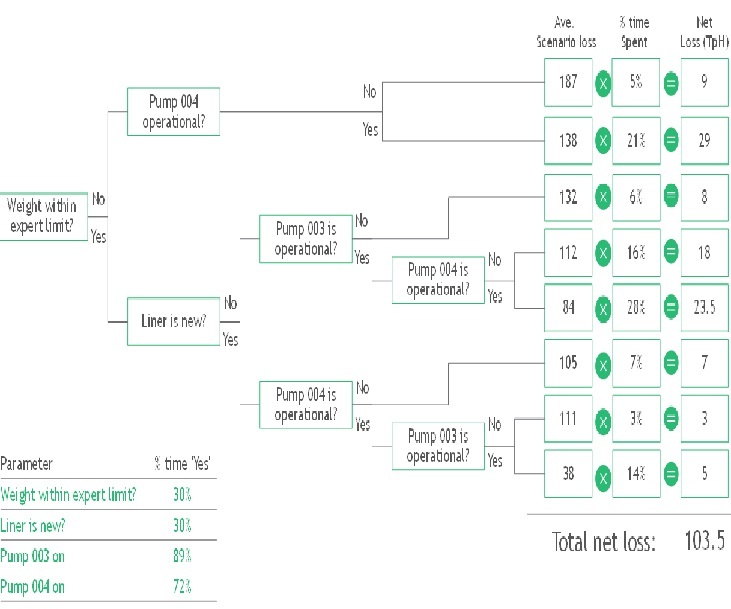For miners in general, and experts and executives in particular, machine learning can serve as a powerful tool to strengthen decision-making about how best to improve operational efficiency and productivity. Mining companies can use machine learning to build a model of their operations—a ‘digital twin'—which replicates a mine's key processes in a computer.
Machine learning differs from other modelling techniques in that it relies on relatively weak assumptions regarding the system being modelled and uses data to ‘learn' how to emulate the real-life system. Miners can use machine-learning models to experiment with different operational parameters in a virtual environment and identify settings that will maximise throughput from mining operations - settings that sometimes go against standard knowledge. Initial pilots in mining suggest that this approach can improve throughput by as much as 3%-5%.
For miners, now is an excellent time to explore machine learning's benefits. Why? Mining is getting more difficult - with yields and grades declining, and pressures on margins mounting. At the same time, recent upticks in commodity prices have put throughput and equipment efficiency back in the spotlight as crucial sources of value. Meanwhile, sensors and machine-learning technologies have advanced, enabling easier and faster processing of more data from more diverse operations, all at ever-decreasing costs. (For instance, most machine-learning algorithms are open source and can be downloaded for free.)
Machine learning in action
Collahuasi's operations team has discovered machine learning's benefits firsthand. A joint venture between Glencore, Anglo American and Mitsui, Compañía Minera Doña Ines de Collahuasi is located at high altitude in northern Chile. With a total copper production of 506,000 tonnes in 2016, it is the second-largest copper operation worldwide and boasts one of the world's largest copper deposits, estimated at 9.974 million tonnes of resources.
In September 2017, Collahuasi decided to join forces with The Boston Consulting Group and Gamma (BCG's data analytics specialists) to explore the use of machine learning to identify throughput improvement levers. Team members built a machine-learning model for the grinding plant, centred mainly at Collahuasi's SAG mills. Almost three years of historical data (at one-minute intervals) for 400-plus variables was used to create and ‘train' the models. The team trialled a variety of machine-learning algorithms (including neural networks, random forests and gradient boosting) and selected the most accurate.
The model helped the team explore and quantify the impact on throughput from variations in key operational parameters. To illustrate, for one SAG mill, the model's output revealed that the optimal ball charge was 18%, which differed from the 19.5% at which the SAG typically operated (figure 1, below). Changing just this operating parameter enabled a potential throughput increase of 2%, much valued in the industry's current environment of rising prices.

The data analytics team uncovered another valuable insight as well, related to the impact of changes in input fragmentation. Because machine-learning models enable analysts to ‘clean' the effect of the hundreds of other variables that affect equipment throughput, miners can quantify the impact of a single variable - in this case, fragmentation. Toward this end, the team was able to estimate that a 10% increase in input fragmentation at the SAG could yield another 2% hike in throughput. But the team also found that there was no increase in throughput beyond an 85% input fragmentation (measured as percentage of material below two-inch diameter). This enabled Collahuasi to better align blasting decisions at the mine site, where higher-energy (and costlier) explosives could deliver higher fragmentation into the SAG.
The team also used these advanced analytics to understand and tackle root causes of throughput loss at the SAG mills. Managers at Collahuasi knew that the biggest contributors to such loss included factors such as pump reliability, stockpile level, pebble-crusher reliability, flotation bottlenecks, liner wear, weight and tank-water levels. However, they hadn't yet been able to quantify the loss associated with each factor, and thus had difficulty prioritising interventions.
The model helped them overcome this challenge. For example, for times when a pump had failed, the analytics team used the model to predict throughput if the pump had been operating instead. They then used this information to build decision trees, combining 1,000-plus ‘loss scenarios' clustered in eight groups (figure 2, below).

For one SAG mill, the team learned that four scenarios accounted for roughly 73% of total expected throughput loss. What's more, eliminating the highest-cost scenario (in which the SAG operator ran the equipment outside of the weight equipment expert system's indication) could deliver a 15-20 tonnes per hour (tph) uplift at that SAG. Additionally, the plant could boost throughput by 60-70tph at another SAG by reducing cyclone pump stoppages. All told, managers discovered that they could unlock a whopping 115-125tph improvement by launching initiatives focussed on improving pump failure rates and ensuring that operators run the equipment within the expert-system weight limits.
Like any organisation that uses machine learning, Collahuasi's next step will be to trial these initiatives (ensuring proper test and control measures) to validate the expected throughput gains. Via this testing process, managers can collect new data and use it to further improve the machine-learning models.
Getting the most from machine learning
Using machine learning can deliver valuable advantages for miners, and many are eager to try it. But adopting this tool also presents challenges. For example, some managers may have unrealistic expectations of the technology, assuming that it will deliver all the answers if they simply dump huge volumes of operational data into it. Or, a mine may encounter resistance from equipment experts who have dedicated their lives to understanding how mining machinery works and who may thus be sceptical of machine learning's usefulness.
To extract maximum value from machine learning, mining companies must foster the right perceptions of and approach to using this tool. The following practices can help:
• Keep the hype in proper perspective. Resist any impulse to see machine learning as a ‘magic box' that spits out answers. Instead, remind yourself and others in your company that machine-learning algorithms are very good at answering questions, not asking them. Human beings must ask the questions, deciding which hypotheses to test and - most important - how to present the data to the algorithms in a sensible way based on those hypotheses. An algorithm can't answer operations questions you didn't know you had.
• Assemble the right team. Build a team comprising business, operations and mining-machinery experts from your mine as well as data analysts who have the knowledge and skills required to correctly use machine-learning algorithms. Without input from operations professionals who understand how the mine's systems work and how to interpret operational data, analysts cannot build a useful machine-learning model. The information in operators' heads regarding how the real-world systems work is not intrinsically contained in the data, and no amount of machine learning can replace it. For collecting data and for conducting subsequent analyses, the quality of the multi-disciplinary team will make a vital difference.
• Manage the change. Operators will inevitably need to trust and be willing to act on the model's recommendations. Having them co-create solutions with data scientists and analysts is a great way to foster these attitudinal and behavioural changes. From the outset, make sure operators understand that using machine-learning models typically will reshape how they approach their work and what their role is in decision making, not eliminate them from these processes altogether. In the end, it'll help them perform their jobs more effectively.
Progressive miners are weighing the possibilities of using machine learning to enhance operational efficiency and productivity. But getting the most from this tool requires some careful thought, an open mind, curiosity and a specific blend of expertise. If industry players take the right approach to adopting machine learning, they will not only demystify data analytics but also deliver actual value in throughput gains and bottom-line improvement.
*Francisco Carvajal Palacios (fcarvajp@collahuasi.cl) is executive vice president of operations at Collahuasi; Agustin Costa (costa.agustin@bcg.com) is a partner and managing director at The Boston Consulting Group; Rohin Wood (wood.rohin@bcg.com) is a principal at BCG Gamma; and Ric Porteous (porteous.ric@bcg.com) is a consultant at BCG Gamma. The authors would like to thank members of the Collahuasi Machine Learning Pilot team - Manuel Vera Sandoval, Carlos Jara Riffo, Nelson Mora Navarrete and Francisca Contreras Acchiardo - for their contributions.


























